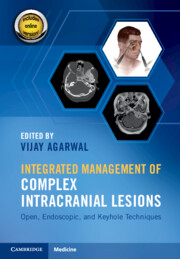Book contents
- Integrated Management of Complex Intracranial Lesions
- Integrated Management of Complex Intracranial Lesions
- Copyright page
- Dedication
- Contents
- Contributors
- Foreword
- Section I Endoscopic Endonasal (EN) Combined Approaches
- Chapter 1 Combined Endonasal Transethmoidal, Transcribriform, and Endoscope-Assisted Supraorbital Craniotomy
- Chapter 2 Combined Endonasal and Transorbital Approach
- Chapter 3 Combined Endonasal and Transoral Endoscopic Approach to the Craniovertebral Junction
- Chapter 4 Combined Endoscopic Endonasal and Transcervical Approach
- Chapter 5 Combined Endoscopic Endonasal and Transcranial Approach to Complex Intracranial Lesions
- Section II Open Combined Approaches
- Index
- References
Chapter 4 - Combined Endoscopic Endonasal and Transcervical Approach
from Section I - Endoscopic Endonasal (EN) Combined Approaches
Published online by Cambridge University Press: 05 October 2021
- Integrated Management of Complex Intracranial Lesions
- Integrated Management of Complex Intracranial Lesions
- Copyright page
- Dedication
- Contents
- Contributors
- Foreword
- Section I Endoscopic Endonasal (EN) Combined Approaches
- Chapter 1 Combined Endonasal Transethmoidal, Transcribriform, and Endoscope-Assisted Supraorbital Craniotomy
- Chapter 2 Combined Endonasal and Transorbital Approach
- Chapter 3 Combined Endonasal and Transoral Endoscopic Approach to the Craniovertebral Junction
- Chapter 4 Combined Endoscopic Endonasal and Transcervical Approach
- Chapter 5 Combined Endoscopic Endonasal and Transcranial Approach to Complex Intracranial Lesions
- Section II Open Combined Approaches
- Index
- References
Summary
Combined skull base approaches have become increasingly popular to address intracranial and head and neck lesions. Improved endoscopic visualization, endoscopic tools, and surgical techniques have allowed safer and more ready access to difficult regions in the skull base. Historically, the parapharyngeal space and infratemporal fossa have been considered distinct locations in the head and neck that have been a challenge to access. This chapter details endoscopic endonasal, transoral, and transcervical approaches, along with a review of general indications, utility, and microsurgical anatomy.
- Type
- Chapter
- Information
- Integrated Management of Complex Intracranial LesionsOpen, Endoscopic, and Keyhole Techniques, pp. 29 - 34Publisher: Cambridge University PressPrint publication year: 2021



